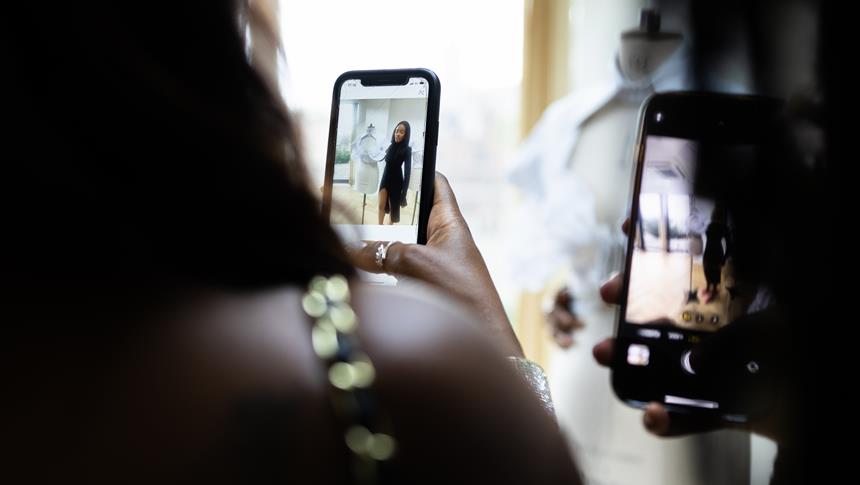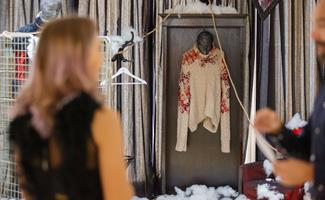In the fast-paced world of fashion, staying on trend isn't just about the clothes you wear; it's about how you engage with the digital world. Social media has become a driving force in shaping the fashion landscape, redefining the way brands connect with their audience.
In this article, we will be looking into how social media can be used in fashion marketing with case studies and real-time examples.
What is social media marketing in fashion?
Social media marketing for fashion is the practice of using social media platforms like Instagram, Facebook, Quora, Pinterest, Snapchat, etc. to leverage sales and build brand awareness.
In the past, Marilyn Monroe, Audrey Hepburn, and Grace Kelly were icons in women’s fashion with many top-tier fashion brands like Gucci, Chanel, and Dior employing their iconic styles in their fashion wear.
Back then, whatever was worn by actors or celebs on-screen obtained a coveted position among the masses. This was primarily how fashion icons were born but the way brands reached their customers decades ago is very different from how things are today.
How social media creates fashion icons
In the digital age, social media is a breeding ground for fashion icons. The ability to amass a following and curate a distinct online persona has become just as important as walking the runway.
Social media marketing has turned ordinary individuals into fashion influencers, reshaping the traditional definition of style icons.
Social media has set fire to the old ways of marketing and fashion goals with hashtags like #wokeuplikethis, #goodhairday, #Outfitoftheday, #POV, #OOTD, and many more.
Even celebrities have taken to these platforms to connect with their fanbases and audiences. Due to this, fashion brands have also started to move with the rise and fall of social media trends to stay in shape in the game.

Social media's influence on fashion
A great example of social media’s incredible influence is the #MeToo movement which triggered at least 19 million photographs uploaded by people all around the world to support this movement.
Due to this, fashion houses have also started releasing clothing ranges that support special occasions and community movements like Black Lives Matter, Pride Month, Women's Rights, Feminism, Thanksgiving, Christmas, Black Friday, Halloween and many more as a part of their fashion marketing strategy.
Evolution of social media marketing for fashion brands from 1980 to 2023
|
Brand |
1980s Marketing |
2023 Marketing |
|
Nike |
Iconic "Just Do It" slogan and celebrity endorsements |
Digital marketing, interactive campaigns, sustainability initiatives |
|
Chanel |
High fashion runway shows and print ads |
Social media campaigns, digital experiences, collaborations with influencers |
What are some social media-inspired fashion trends?
|
Top Fashion Trend |
Description |
|
Sustainable fashion initiatives |
Increasing emphasis on eco-friendly and ethical practices. The organic clothing market in the U.S.A. is predicted to grow considerably between 2023 and 2030. |
|
Virtual fashion shows |
Adoption of virtual platforms, especially post-pandemic. |
|
Influencers collaborations |
Diverse and inclusive collaborations with influencers. |
|
Rise of second-hand trends |
The growing popularity of second-hand and vintage fashion. This is a major trend on Instagram and Facebook where you can find many groups and influencers under the terms “Vintage” and “Cottagecore”. |
|
Body positivity movement |
Continued emphasis on diverse representations in fashion. Awareness of different body shapes and types resulted in the rise of clothing for each body type. Fashion experts and stylists resorted to blogs and YouTube to promote content on how to dress for your body type. Skin colour was also highly covered, as seen in beauty commercials by Dove and models such as Winnie Harlow. Many plus-size fashionistas arose, like Ashley Graham, Iskra Lawrence etc. |
|
Technology-driven innovations |
Integration of virtual fitting rooms and tech-driven fashion. As seen in many fashion brands, you can try the dress on virtually before buying it. |
|
Advocacy for ethical practices |
Growing awareness and support for ethical fashion practices. Sustainability has taken centre stage with the likes of Primark, H&M, and Nike resorting to solid CSR initiatives to ensure sustainable clothing and fashion gear. |
What are the top social media platforms for fashion marketing?
The global fashion landscape is significantly influenced by social media, with certain countries leading the way.
Here's a glimpse into how fashion houses leverage these platforms to capture the market in different countries:
|
Country |
Largest Social Media Platform |
Fashion Influence Strategy |
|
United States |
|
Collaborations with influencers and celebrities. |
|
China |
WeChat, Weibo |
Integration of social commerce and live streaming. |
|
India |
Facebook, YouTube, Instagram |
Short videos and DIYs. Emphasis on cultural diversity, fusion wear, work wear, and traditional wear. |
|
United Kingdom |
Twitter, Pinterest, Instagram |
Innovative, sustainable clothing range, fast fashion, and avant-garde fashion marketing. (Source: Statitsa) |
Best practices for social media marketing for fashion brands
According to Martin Fox, a digital marketing expert, keeping up with the latest trends is crucial for fashion brands in 2023. There are many benefits of social media marketing in fashion. To best experience these benefits, consider the guidelines listed below:
1. Build brand awareness
Social media is a powerhouse for creating brand awareness. By strategically showcasing your brand's personality, values, and unique selling points, you can establish a memorable presence in the digital fashion realm.
2. Influencer marketing
Fashion houses collaborating with influencers is a game-changer. These social media personalities can sway consumer opinions and drive trends. A well-executed influencer marketing strategy can significantly boost a fashion brand's reach and credibility.
Influencers have an empathetic and persuasive undertone to their content and are generally more trusted as icons compared to celebrities. You can win favor among the masses by teaming up with the right influencers.
3. Paid social media advertising
Investing in paid social media advertising amplifies a brand's visibility. With targeted ads, fashion brands can reach specific demographics, ensuring their message resonates with the right audience at the right time.
4. User-generated content
The era of consumers being passive observers is long gone. Encouraging users to generate content related to your brand not only fosters a sense of community but also provides authentic endorsements that can influence potential customers.
5. Social media contests and giveaways
Everyone loves a good contest or giveaway. Utilising these tactics on social media not only engages your audience but also creates buzz around your brand, driving traffic and helping your brand stay relevant.

How social media has changed the game in the fashion industry
The landscape of fashion marketing has undergone a revolutionary transformation, thanks to social media.
Let's use Chanel as an example and compare their tactics from the 90s to 2023:
|
Criteria |
1990s Chanel |
2023 Chanel |
|
Iconic Designer |
Karl Lagerfeld |
Virginie Viard |
|
Signature Style |
Elegance and classic tweed |
Modern elegance with streetwear influences |
|
Marketing Approach |
Traditional runway shows |
Digital runway shows, social media campaigns |
|
Brand Collaborations |
Limited |
Extensive collaborations with influencers |
|
Inclusivity Initiatives |
Minimal |
Emphasis on diversity and inclusion |
|
Technological Integration |
Limited |
Virtual fitting rooms, AR experiences |
The direct and immediate connection with consumers has shifted the power dynamic, allowing brands to adapt swiftly to changing preferences.
The benefits of social media marketing extend beyond the digital realm, influencing how fashion brands operate and innovate. A good fashion marketing degree can help you gain the necessary skills to leverage this opportunity.
How to use social media for fashion media and promotion
1. Create a consistent posting schedule
Consistency is key. Establishing a regular posting schedule keeps your audience engaged and aware of your brand's activities.
2. Create Instagram and Facebook shops
Turning your social media profiles into virtual shops provides a seamless shopping experience for your audience. Integrating e-commerce directly into these platforms enhances accessibility.
3. Prioritise customer service
Social media is not just a showcase, it's a conversation. Prioritising customer service on these platforms builds trust and loyalty among your audience.
4. Content marketing
Content is the currency of the digital age. From visually stunning images to engaging videos, effective content marketing is essential for fashion brands looking to thrive online.
5. Higher engagement with the target audience
Understanding your audience is crucial. Social media analytics provide insights into what resonates with your target demographic, allowing you to tailor your content for maximum engagement.
As the digital landscape continues to shift and evolve, social media, due to its increasing influence on the masses, has become a non-negotiable asset to the fashion industry. From building brand awareness to creating fashion icons, the impact is profound.
Social media and fashion are now interconnected, with fashion houses not just adopting best practices and following trends but setting them and creating a brand image that resonates with the new generation.

Hence equipping yourself with reputed fashion and marketing courses can help you find sure footing in this rapidly evolving industry.
Consider studying a fashion media and marketing degree to become a competent professional in the industry.
Click here to learn more!


 Fashion Business and Management 101: Mastering the Art of Selling Style
Fashion Business and Management 101: Mastering the Art of Selling Style  How can an MA in Fashion Business and Management help you shape your career as an industry leader?
How can an MA in Fashion Business and Management help you shape your career as an industry leader?  What are the Top Future Fashion Trends?
What are the Top Future Fashion Trends?